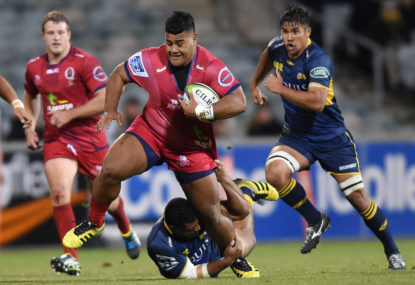It has been a forgettable week for Australian sportsmen.
Over in South Africa, ball-tampering revelations caught on camera led to a voluntary stand-down by captain Steve Smith, vice-captain David Warner and three demerit points for the player involved, Cameron Bancroft. There remain plenty of questions for head coach Darren Lehmann to answer too.
At the O2 arena in London, 38-year-old ex-bouncer Lucas Browne was left motionless, face down on the canvas after being knocked out in a world heavyweight title eliminator by ‘the body-snatcher’ Dillian Whyte. He was taken to hospital on a stretcher, with an oxygen mask attached to his face.
Meanwhile, rugby coach Eddie Jones has continued to attract the opprobrium of the UK press after England’s failure in the recent Six Nations tournament. Although they went through the official channels, part of their preparation lent itself to accusations of a different form of ‘tampering’.
The South African referee due to run the line for the climactic game against Ireland last weekend, Marius van der Westhuizen, had been invited to referee an England training session at their training base in Pennyhill Park four days before the match.
This created a potential conflict of interests which World Rugby could only resolve by standing down van der Westhuizen from the game at Twickenham. The governing body was forced to issue the following statement:
“World Rugby has also clarified with teams that, in addition to the regular pre-match coach and referee meetings, senior elite teams will continue to have the opportunity to request that a member of the high-performance match official panel attends training providing that the individual is not a member of the match official team officiating that team at a later date within the current competition or Test window.”
Van der Westhuizen happened to be the referee for the game between the Stormers and Reds at Newlands, and he was the only home official appointed to a Super Rugby match in the last round of matches. All the other appointments were strictly neutral.
His officiating was a curiously mixed bag. He was lenient on more than one potential head-high tackle by the Reds in defence, but he penalised the Queenslanders mercilessly at scrum time.
Van der Westhuizen’s double-edged officiating affected Reds tight-head prop Taniela Tupou more than anyone. The ‘Tongan Thor’ received no on-field punishment for a head-high shot on Stormers’ winger Craig Barry in the ninth minute of the game, but has since been cited for the incident by the commissioner.
Supersport analyst Nick Mallett felt it should have been a red card at the time: “I do not know how this foul went unpunished. It was impossible for all four (referee, two assistant referees and the television match official) to miss it.”
Tupou may have got off lightly for the tackle, but he was more than repaid by van der Westhuizen at the scrum. This area of the game had promised to be one for the rugby connoisseur prior to the match. The Reds have built the outstanding scrumming unit in Australia franchises so far this season, and the scrum has become the basis of their game. On Saturday they faced their most stringent test to date, against a Stormers outfit featuring two props of genuine Springbok quality in Steven Kitshoff and Wilco Louw.
In the event, van der Westhuizen removed the contest entirely by constantly penalizing Tupou for early engagement against the Stormers’ second choice loosehead, JC Janse van Rensburg. He pinged him three times (one half-arm and two full arm sanctions) before Tupou was finally replaced in the 52nd minute.
With Kitshoff arriving from the bench two minutes before that, he and Louw were able to dominate, squeezing a further three penalties and one turnover from the Reds’ outmatched reserve props, Sef Fa’agase and JP Smith at a crucial time in the game.
Having reviewed all the scrums at which Tupou was penalised, I still find van der Westhuizen’s decisions mystifying – even more so when compared with Tupou’s pre-scrum routine the previous week against the Jaguares.
Whoever has been ‘tampering’ with Taniela Tupou’s scrum technique at the Reds is doing a spectacularly good job, because Tupou (especially in Sekope Kepu’s absence) has been far and away the best tighthead in his Conference, and one of the top three in the tournament overall.
Against the Mario Ledesma-coached Jaguares, Tupou was opposed by two Puma props with international experience: young Felipe Arregui (one cap) and Santiago Garcia Botta (22 caps). Interestingly, in a match marked by constant scrum resets, the neutral referee from New Zealand (Paul Williams) only issued two half-arm penalties for pre-engagement, and both of those went in Tupou’s favour and against his opponents!
In the battle of the youngsters, Tupou made a mess of his opposite number Arregui, and he did it on both feeds:
Let’s deal with the issue of pre-engagement first. The problem can arise in the gap between the second and third refereeing commands, ‘bind’ and ‘set’, with either or both props failing to maintain the space between them after making the bind. In the above example, it is clear that Arregui gets across the gap first and Tupou is forced to take an initial step backwards with his right foot.
Making the first move does not save Arregui’s skin, however. As soon as Tupou settles into his power position, he is able to penetrate the gap between the Argentine loose-head and his hooker Agustin Creevy:
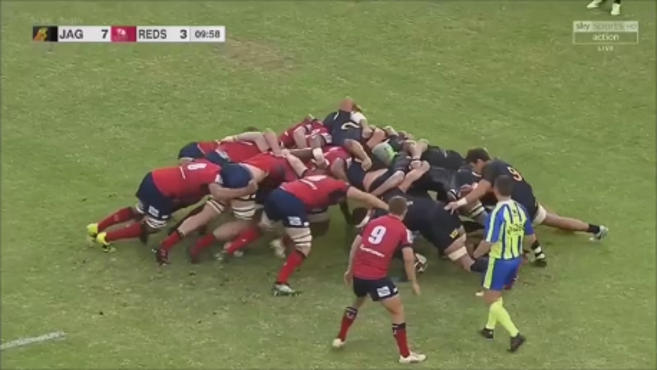
Here is a classic case of a loosehead failing to do his job under pressure. Tupou has passed Arregui’s left shoulder and he can no longer protect Creevy. As a result, the pressure has forced the Jaguares’ hooker upwards and compromised the integrity of the bind with his loosehead.
Unfortunately, on this occasion the effect was spoiled by the ill-discipline of number six Angus Scott-Young on the side of the scrum, trying to rake the ball back on the Reds’ side. It was to be the only scrum penalty the Jaguares won in the course of the game.
Tupou was just as effective on Queensland’s own feeds:
Again Arregui beats Tupou across the gap at ‘set’, forcing that first step backwards, but after that it is all Tongan power. Tupou takes a second step outside, and James Slipper and Alex Mafi follow him on a slant to the right. By the end of the scrum, Arregui is left facing towards his own goal-line, and both Slipper and Mafi have actually changed channels so that they are ‘wrong side’ of the Jaguares’ tighthead and hooker!

One important ripple effect of scrum power is the impact it has on back-row defence on the subsequent attacking play – and this can work both ways. Here the Jaguares’ flanker on Slipper’s side has been drawn into the (losing) scrum battle completely as the ball emerges, and ends up way behind his own number eight on the Reds following back-line move:
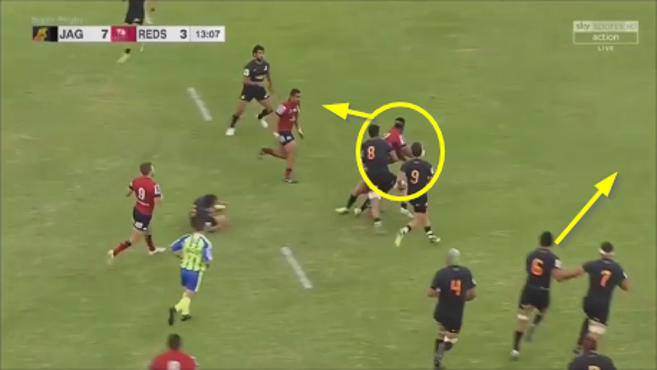
Number six Pablo Matera is too far away from Samu Kerevi when he goes to offload to Chris Feauai-Sautia in the tackle to do anything other than corner-flag hopefully.
The Reds had, in fact, been a victim of their own success at the scrum much earlier in the match:
In this case it is Adam Korczyk who gets sucked in by a winning scrum and forgets his defensive duties:
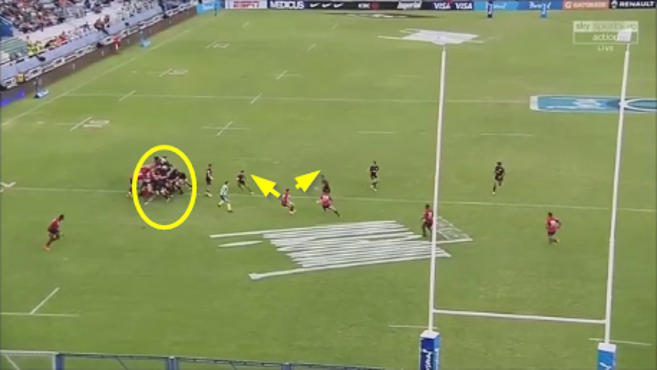
With Korczyk fully committed to the scrum surge, the first defender Jake Tuttle is left with a choice between shifting out onto the Jaguares receiver (number 12 Santiago Gonzalez Iglesias), or ‘staying home’ to fill the space between the scrum and Jono Lance. Unfortunately, he is pulled out of that space, leaving Jaguares right winger Bautista Delguy free to score without a hand being laid on him.
Another ripple effect of scrum pressure is the translation of that pressure to the half-backs. As pressure is passed on, it becomes greater and more significant:
The pressure is passed on from the Jaguares’ number nine to his first receiver Nicolas Sanchez, who promptly knocks a poor delivery forward, giving the Reds prime attacking position deep in the home side’s 22.
Let’s leave the final word to Taniela Tupou, who completed his dismantling of Arregui at this conclusive scrum:
The Puma loosehead is so overwhelmed by Tupou’s power that he can find no other solution but to fall miserably into the middle of the tunnel, with only his legs sticking out of the scrum:
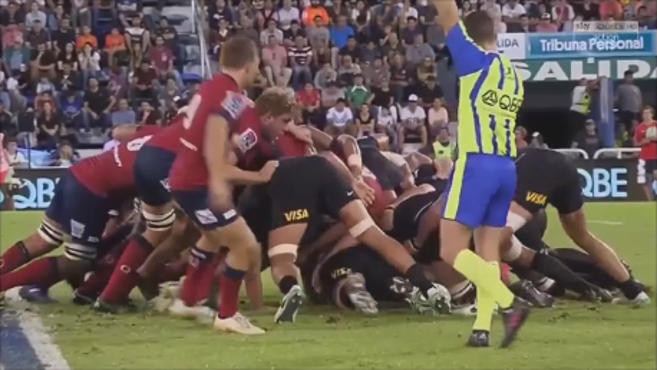
Summary
The question of neutral referees will again raise its head after the performance of Marius van der Westhuizen in the Stormers-Reds match. Van der Westhuizen did the Reds a favour by missing Taniela Tupou’s head-high shot on Craig Barry, but he more than made up for it by crucifying them at scrum time.
The refereeing guidelines issued with the current engagement rules explicitly advise officials to “not waste time at the scrum process by being pedantic – the new engagement sequence should reduce scrum time and scrum issues”. This was not the case at Newlands, and the audience was deprived of the rich promise of a ‘battle royale’ as a result.
Taniela Tupou was never allowed to scrummage, even though the previous game in Buenos Aires proved that he is not by nature or inclination one of those props who practises ‘early engagement’.
Whoever is coaching Tupou in scrum technique at Ballymore is clearly ‘tampering’ to excellent (and technically correct) effect – so much so that all three of the first choice Reds front row (Tupou, Slipper and hooker Brandon Paenga-Amosa) may be in line for a call-up to for Michael Cheika’s Wallaby match-day squad in June.
Although the number of scrums has declined steadily in the pro era, the set-piece is the rock-solid foundation of Brad Thorn’s new model Queensland Reds, and a reminder of the pressure ripples a good scrum can send out into corners of the team far beyond it. It also represents the blue collar ethic, the honesty of the team Thorn is building, brick by brick. There are no shortcuts.
Whether that is enough by itself to send out more than the occasional tremor into the New Zealand franchises remains to be seen – but it is without doubt a timely nod to the flinty bedrock of forward play, and the core values of hard work and honesty in a sporting nation that, right now, could probably do with a bit of both.





























































































